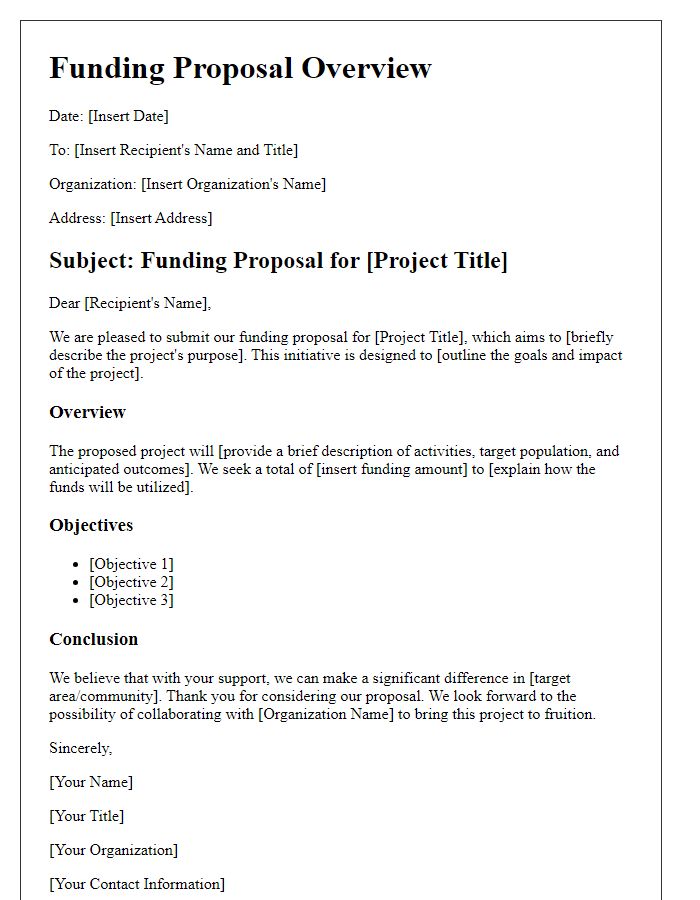Are you gearing up to submit a grant proposal and wondering how to craft the perfect letter? Writing a clear and persuasive letter can be the key to securing funding for your project. In this article, we'll walk you through a streamlined template that highlights important elements while maintaining a professional tone. Let's dive into the essentials that can elevate your proposal and help you make a compelling case for support!

Clear and compelling project summary
A grant proposal submission must include a clear and compelling project summary that outlines the objectives of the initiative, target beneficiaries, and expected outcomes. For instance, the project titled "Urban Green Spaces Initiative" aims to enhance the quality of life in downtown San Francisco by transforming vacated lots (approximately 15 lots covering 2 acres) into vibrant community gardens. This project seeks to engage local residents (over 1,000 community members) in sustainable practices, improving urban biodiversity, and promoting mental health benefits. By collaborating with organizations such as "Friends of the Urban Forest," the initiative anticipates increased green coverage (up to 30%) in urban areas, fostering educational outreach programs and volunteer opportunities. Sustainable practices will include rainwater harvesting systems and native plant gardens, resulting in long-term ecological impact and community engagement enhancement.
Detailed budget and funding needs
A detailed budget is essential for evaluating funding needs in grant proposals, providing a comprehensive overview of projected expenses (such as personnel costs, equipment, supplies, and indirect costs). For instance, personnel costs might include salaries for three full-time researchers ($80,000 each annually) and part-time administrative support ($30,000 annually). Equipment costs can encompass lab instruments like spectrophotometers ($15,000 each) and computers ($2,500 each) necessary for data analysis. Additionally, supplies such as reagents and materials may necessitate an annual budget of $10,000. The proposal should also outline indirect costs, calculated as a percentage (commonly 10%-20%) of total direct costs, covering overhead expenses. A well-structured budget plan facilitates the funding agency's assessment of the project's viability while ensuring transparency and accountability in financial management.
Strong alignment with grant goals
The project proposal focuses on community health initiatives aimed at addressing chronic illnesses such as diabetes and hypertension in underserved urban areas like the South Side of Chicago. These initiatives align strongly with the goals of the Healthy Communities Grant Program, which prioritizes projects that enhance health outcomes and increase access to healthcare. Targeted interventions will include educational workshops aimed at promoting nutrition and physical activity, especially among minority populations that are disproportionately affected by these conditions. The proposed budget of $150,000 will fund partnerships with local clinics and health organizations, ensuring sustainable support for preventive care and health education. Additionally, tracking metrics such as patient engagement and health outcomes will demonstrate the effectiveness of the program and its impact on community health.
Evidence of organizational capacity
A well-structured grant proposal submission is essential for demonstrating an organization's capacity to effectively manage and execute the proposed project. Highlight key operational elements, including a dedicated project team with relevant experience, usually consisting of five members with expertise in areas such as project management, community engagement, and financial oversight. Emphasize the organization's track record, showcasing previous successful projects with measurable outcomes, such as the 20% increase in community engagement for past initiatives. Utilize relevant certifications and partnerships, specifically listing collaborations with local nonprofits or educational institutions, as evidence of commitment and resource sharing. Detail funding received in the past, such as a $50,000 grant from a prominent foundation in 2022, which equipped the organization with the necessary infrastructure to manage funds responsibly and efficiently. This comprehensive overview illustrates the organizational capacity to not only secure but also meet the demands of the proposed project.
Persuasive impact and outcomes statement
A compelling impact and outcomes statement in a grant proposal emphasizes the transformative benefits of a project designed to address specific community needs. This statement highlights the anticipated changes resulting from funding, such as improved educational access for underserved populations, particularly in areas with high poverty rates, or increased healthcare services in rural regions with limited access to medical facilities. For instance, projects may aim to enhance literacy rates by 20% within three years or reduce local food insecurity by providing fresh produce to over 500 families monthly. A clear measurement framework, including metrics and evaluation methods, demonstrates accountability and the feasibility of achieving these outcomes, ensuring that funders recognize the potential for sustainable change. Engaging narratives and statistical evidence will showcase the urgency of support, ultimately crafting a persuasive case for the project's significance and necessity in fostering positive social impact.













Comments